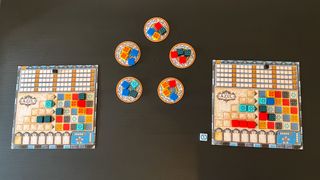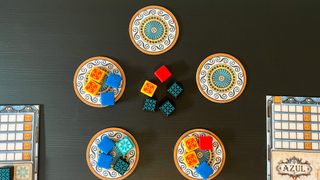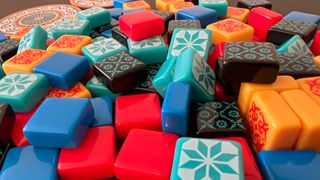12DOVE Verdict
While it may seem simple at first, Azul's abstract strategy design means you're quickly one-upping both yourself and your opponents to evolve your playstyle and take advantage of the mechanics in place - all while offering a refreshingly short and snappy experience perfect for weeknight play.
Pros
- +
Logic systems that scale with your own experience
- +
Fast and easy to pick up
- +
Shorter completion time encourages multiple games
Cons
- -
Balance can sometimes be tipped by the third round
- -
Boards can warp slightly
Why you can trust 12DOVE
Azul is a colorful tile drafting strategy game for up to four players, with a massive range of different logic puzzles baked into the core gameplay. Working in tandem, these systems organically grow as your understanding of the game evolves, producing an ever-changing experience with a difficulty ramp that meets your own skill level naturally.
That's a rare beast, and barring a few mid-game balancing issues, Azul pulls off its intricate machine-building with aplomb. I put Azul to the test over the course of five weeks, playing at two, three, and four person tables, to see exactly where it sits among the best board games on the market right now.
What is it, and how does it work?

Draft tiles and race against the clock to fill out your wall and score points.
Price: $39.99 / £39.99
Players: 2 - 4
Ages: 8+
Difficulty: Easy (with a sliding scale)
Setup: 2 mins
Lasts: 20 - 30 mins
Play if you enjoy: Kingdomino, Sagrada, Realm of Sand, Spirits of the Forest, Isle of Cats, Patchwork
Azul is set against the backdrop of King Manuel I's return to Portugal - he's seen some sights while away in Seville, and discovered the azulejos tiling of the Alhambra palace. As a tile artist yourself, you're perfectly positioned to fulfil his wish of decorating his own palace in the same style, which means it's time to head to the market, gather your supplies, and get to work.
In each round, players must draft tiles from circular marketplace (taking all of one color at a time and placing the rest into the middle), line them up in rows on their board, and start filling their walls once the market has been all bought up. It's not as straightforward as this makes it sound, though. Any tiles that can't fit on your pattern lines (which is likelier than you think, seeing as you can only hold one color at a time, and can't place a tile of the same color as one you already have on that row) fall to the ground. This costs you valuable points.
From the very moment those first tiles are laid out, Azul forces you to play differently every time
Speaking of which, points are scored based on how many tiles each new placement touches as it's added to the wall, with end-of-game tallies also incorporating the number of rows, columns, and full color sets you've managed to complete. Rounds finish once a single player has completed a full row of their wall.
Take a trip to Portugal
The abstraction of Azul means that the Portuguese influences are found in the lore and backstory, the design of the boards and tiles, and the overarching narrative. Logic and mechanics are kept clean from these colorful inspirations, and - boiled down - could fit any setting.
That's not to bemoan Azul's central logic, but considering similar games like Kingdomino and Isle of Cats manage to build their worlds into mechanics while still retaining a similar competitive strategy element, I would have liked to see a little more atmosphere baked in here.
Gameplay - is it any good?

The strategy to Azul sneaks up on you, to the point where I'm loathe to go into too much detail around specifics - it's just too much fun discovering each piece of the puzzle yourself.
While the drafting and machine-building systems may seem simple at first glance, each playthrough will spark inspiration for a new tactic or approach. We had plenty of "one more game, I want to try something" moments in our testing, which had everyone at the table intrigued.
Organic strategy
From the very moment those first tiles are laid out, Azul forces you to play differently every time. I gradually fell into a starting tactic, which would shift slightly depending on the combinations of colors available from the initial round, but still appreciated the demand for flexibility running throughout each stage.
Each playthrough will spark inspiration for a new tactic or approach
That's likely due to the fact that Azul works several different kinds of logic all the time. This is more than one puzzle; there are so many systems running hand in hand that calculating each move becomes an incredibly satisfying decision tree. You're racing against the clock, drafting with as much efficiency as possible, and lining up your board for a maximum profit to opponents' loss ratio. Even picking your tiles becomes a Nim-like game of maths, probability, and reading your opponents' intentions.
The result of this complex combination of systems and logic is an organic strategy experience that each player shapes for themselves. As in all good drafting experiences, everyone at the table's playing a slightly different game and is developing a greater understanding of exactly what's being asked of you with every round.

That means the difficulty is dynamic enough to cater to those after a board game for kids which can easily transition into a high-stakes board game for adults later on.
Of course, if one player manages to kick off with two or three excellent rounds, things can steamroll. I often found that once a player had a significant enough lead (perhaps 10 points) by the middle of the game, there was no catching them. That meant many wins were often decided well before the end, despite efforts to balance in extra points once the game had concluded.
Overall - should you buy Azul?

I've taught two players to play Azul on separate occasions, and both were up and running, developing their own strategies, and engaging with each intricate system within two or three games. Once the phases and processes are in place, the required strategies naturally fall into place and begin evolving. Azul can cater to up to four players, but it's an excellent board game for two players if you're after a head to head battle.
Each game takes between 20 and 30 minutes, so Azul is also a perfect weeknight pick-up-and-play experience. However, it's just as easy to slip into a 'best of three', 'best of five' mindset thanks to that deceivingly simple strategy system and individual evolution.

Managing Editor of Hardware at 12DOVE, I originally landed in hardware at our sister site TechRadar before moving over to GamesRadar. In between, I've written for Tom’s Guide, Wireframe, The Indie Game Website and That Video Game Blog, covering everything from the PS5 launch to the Apple Pencil. Now, i'm focused on Nintendo Switch, gaming laptops (and the keyboards, headsets and mice that come with them), PS5, and trying to find the perfect projector.

"30 years of history reside in our tape backups": PlayStation's building a game preservation mineshaft vault with 200 million files going back to a 1994 build of PS1 JRPG Arc the Lad

The other big Soulslike out this week has some Bloodborne and Dark Souls 3 in its combat, dev says, but "we would rather call AI Limit an action RPG"

The Last of Us showrunner says "so much" has happened in the five-year gap since we last saw Joel and Ellie: "That's part of the mystery of the season"










